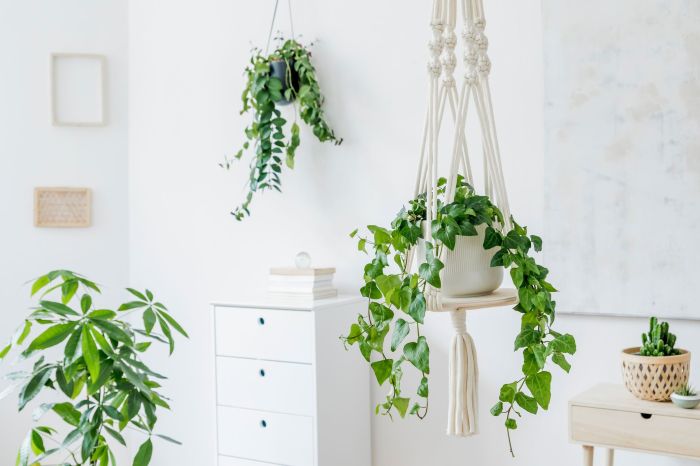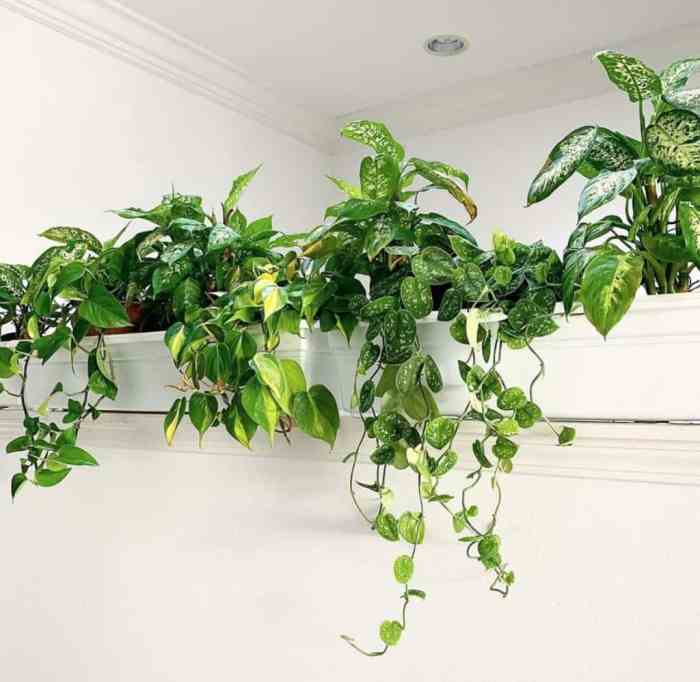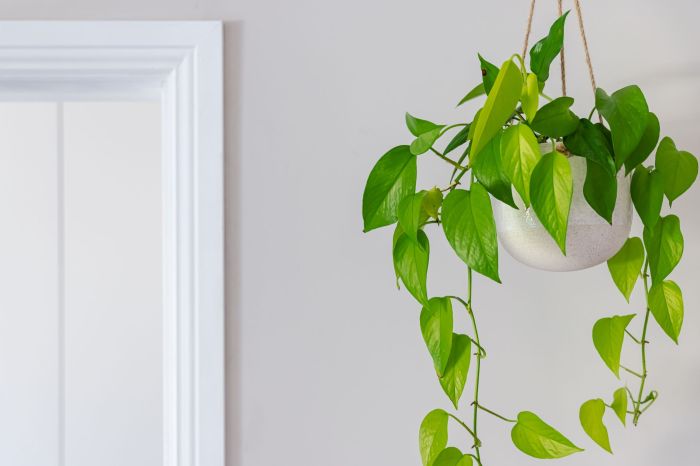Hanging vine plants indoor are a captivating addition to any home, offering a touch of nature and elegance. From cascading greenery to trailing tendrils, these versatile plants add life and character to any room. Whether you’re a seasoned plant enthusiast or just starting your indoor garden, this guide will provide you with everything you need to know about choosing, caring for, and styling hanging vine plants indoors.
From the popular pothos to the delicate maidenhair fern, discover the best hanging vine plants for your indoor space. Learn how to create a lush vertical garden or add texture and interest to a room with these versatile plants. This comprehensive guide will empower you to transform your indoor environment into a thriving oasis.
Indoor Hanging Vine Plants
Hanging vine plants have become increasingly popular for indoor use, offering a touch of nature and elegance to any space. These plants not only add aesthetic value but also provide numerous benefits for your health and well-being.Indoor hanging vine plants can improve air quality by absorbing toxins and releasing oxygen.
They can also help to reduce stress and anxiety by creating a calming and serene atmosphere. Additionally, these plants can help to regulate humidity levels and create a more comfortable living environment.
Most Popular Hanging Vine Plants for Indoor Use
There are many different types of hanging vine plants that are suitable for indoor use. Some of the most popular varieties include:
- Pothos (Epipremnum aureum)
- Philodendron
- Spider plant (Chlorophytum comosum)
- English ivy (Hedera helix)
- String of pearls (Senecio rowleyanus)
Choosing the Right Hanging Vine Plant for Your Space
When choosing a hanging vine plant for your space, there are several factors to consider:
- Light requirements:Different plants have different light requirements. Some plants, like pothos and philodendron, can tolerate low light conditions, while others, like string of pearls, need more light to thrive.
- Size:Consider the size of the plant and the space you have available. Some plants, like English ivy, can grow quite large, while others, like string of pearls, are more compact.
- Care requirements:Some plants are more low-maintenance than others. Consider your lifestyle and how much time you have to care for a plant.
By considering these factors, you can choose the right hanging vine plant that will add beauty and benefits to your indoor space.
Hanging vine plants indoors add a touch of greenery and vibrancy to any space. For a more versatile display, consider using indoor hanging baskets for plants . These baskets allow you to suspend your hanging vine plants from the ceiling or walls, creating a cascading effect that can enhance the aesthetics of your indoor space.
The baskets come in various sizes and materials, so you can choose one that best complements your decor and plant selection.
Care and Maintenance

Maintaining healthy and thriving hanging vine plants indoors requires specific care and maintenance practices. These plants have unique requirements for watering, lighting, and fertilization, and understanding these needs is crucial for their optimal growth and well-being.
Watering should be done regularly, allowing the soil to dry out slightly between waterings. Overwatering can lead to root rot, so it’s essential to avoid waterlogging. The frequency of watering will vary depending on factors such as the type of plant, the size of the pot, and the humidity level of the environment.
Lighting, Hanging vine plants indoor
Hanging vine plants typically prefer bright, indirect light. They can tolerate low-light conditions, but their growth and overall health may be compromised. Placing them near a north-facing window or in a room with plenty of natural light is ideal. If natural light is limited, supplementing with artificial light can help support their growth.
Fertilization
Fertilizing hanging vine plants every few weeks during the growing season can provide them with essential nutrients. Use a balanced liquid fertilizer diluted to half strength. Avoid over-fertilizing, as it can damage the roots and burn the leaves.
Propagation
Propagating hanging vine plants is a simple and effective way to increase their number. Stem cuttings can be taken from healthy plants and rooted in water or soil. To propagate in water, place the cutting in a glass of water and wait for roots to develop.
Once the roots are established, the plant can be transferred to soil.
Design and Decor

Hanging vine plants are a versatile and stylish way to add life and interest to your home. They can be used to create a variety of looks, from lush vertical gardens to cascading displays. Here are a few ideas for incorporating hanging vine plants into your home decor:
One of the most popular ways to use hanging vine plants is to create a vertical garden. This is a great way to add greenery to a small space or to create a focal point in a larger room. To create a vertical garden, simply hang a series of planters on the wall and fill them with your favorite vine plants.
You can use a variety of plants to create a vertical garden, including pothos, philodendron, and ivy.
Another popular way to use hanging vine plants is to create a cascading display. This is a great way to add a touch of drama to a room. To create a cascading display, simply hang a planter from the ceiling and let the vines trail down.
You can use a variety of plants to create a cascading display, including spider plants, ferns, and hoyas.
Hanging vine plants can also be used to add texture and interest to a room. For example, you can use a hanging vine plant to fill in a bare corner or to add a touch of greenery to a bookcase.
You can also use hanging vine plants to create a living wall. This is a great way to add a touch of nature to your home and to improve the air quality.
Tips for Using Hanging Vine Plants in Your Home Decor
- Choose the right plants for your space. Some vine plants are better suited for certain environments than others. For example, pothos and philodendron are both low-maintenance plants that are ideal for beginners. Spider plants and ferns are also good choices for hanging baskets.
- Hang your plants at the right height. You want your plants to be high enough so that they don’t get in the way, but low enough so that you can still enjoy them. A good rule of thumb is to hang your plants about eye level.
- Water your plants regularly. Vine plants need regular watering, especially during the growing season. Be sure to check the soil regularly and water your plants when the top inch or two of soil is dry.
- Fertilize your plants monthly. Vine plants need regular fertilization to stay healthy and vigorous. Use a balanced fertilizer that is diluted to half strength.
- Prune your plants regularly. Pruning helps to keep your plants healthy and looking their best. Remove any dead or damaged leaves and stems, and trim back any vines that are getting too long.
Troubleshooting Common Issues

Hanging vine plants indoors can bring a touch of nature and elegance to any space. However, even the most experienced plant enthusiasts may encounter occasional issues. Identifying and addressing these problems promptly can ensure the health and beauty of your hanging vine plants.
Pests and Diseases
Pests and diseases can be a nuisance for hanging vine plants. Common pests include aphids, mealybugs, and spider mites. Diseases may include powdery mildew, root rot, and leaf spot. Regular inspection and prompt treatment are essential to prevent infestations and infections.
Insufficient Light
Hanging vine plants require adequate sunlight for optimal growth. Insufficient light can lead to leggy growth, yellowing leaves, and reduced flowering. Ensure your plants receive the recommended amount of light by placing them near a window or using artificial lighting.
Overwatering or Underwatering
Both overwatering and underwatering can harm hanging vine plants. Overwatering can lead to root rot and yellowing leaves, while underwatering can cause wilting and stunted growth. Water your plants thoroughly when the soil feels dry to the touch.
Improper Soil
The soil used for hanging vine plants should be well-draining and rich in organic matter. Poor-quality soil can lead to nutrient deficiencies, waterlogging, and root problems. Use a potting mix specifically formulated for indoor plants.
Hanging vine plants are a popular choice for indoor gardening, adding a touch of greenery and freshness to any room. These plants, such as pothos and philodendron, are known for their trailing stems that can cascade down from hanging baskets or pots.
If you’re looking for more options for trailing greenery, consider exploring the wide variety of trailing house plants available, each with unique foliage and growth habits. Hanging vine plants indoor bring a touch of the outdoors in, creating a relaxing and inviting atmosphere.
Root Bound Plants
As hanging vine plants grow, they may become root bound. This occurs when the roots fill the container and become entangled. Root bound plants can experience stunted growth and nutrient deficiencies. Repot your plants into a larger container when necessary.
Advanced Techniques
Advanced techniques for growing and maintaining hanging vine plants indoors can elevate your home décor to new heights. These techniques allow you to create unique shapes, forms, and even living art installations that add a touch of nature and sophistication to any space.
With careful planning and execution, you can harness the natural growth habits of hanging vine plants to create stunning displays that will impress guests and enhance your living environment.
Creating Unique Shapes and Forms
By training and pruning hanging vine plants, you can create a variety of shapes and forms. Trellises, wire frames, and hoops can be used to guide the growth of vines, encouraging them to form arches, spirals, and other decorative patterns.
Regular pruning helps to maintain the desired shape and prevent the plant from becoming overgrown. By selectively removing stems and leaves, you can create open spaces within the foliage, adding depth and interest to the overall design.
Living Art Installations
Hanging vine plants can be used to create living art installations that bring nature indoors. By combining different species of vines with contrasting colors, textures, and growth habits, you can create unique and dynamic displays.
Consider using hanging planters or macrame hangers to suspend vines at different heights, creating a sense of movement and visual interest. By incorporating natural elements such as stones, driftwood, or moss, you can create a truly immersive experience that blurs the lines between art and nature.
Final Wrap-Up
Incorporating hanging vine plants into your home decor is not just about adding greenery; it’s about creating a living work of art. With proper care and maintenance, these plants will thrive and bring years of joy and beauty to your indoor space.
So, embrace the transformative power of hanging vine plants and elevate your home’s ambiance with their natural elegance.
Frequently Asked Questions: Hanging Vine Plants Indoor
How often should I water my hanging vine plants?
Water your plants when the top inch of soil feels dry to the touch. Overwatering can lead to root rot, so it’s best to err on the side of caution.
What is the best lighting for hanging vine plants?
Most hanging vine plants prefer bright, indirect light. Avoid placing them in direct sunlight, as this can scorch their leaves.
How can I propagate hanging vine plants?
Propagating hanging vine plants is easy! Simply take a cutting from a healthy stem and place it in a glass of water. Within a few weeks, you should see roots developing. Once the roots are about an inch long, you can transplant the cutting into a pot of soil.